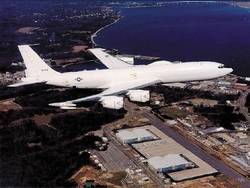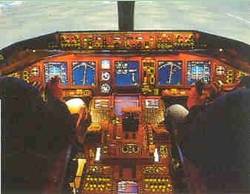Wed, Jan 22, 2003
Mercury Gets 777-Style Display
 An E-6B Mercury that has been modified with a new
cockpit and an advanced communications package arrived at Naval Air
Station Patuxent River earlier this month, where joint testing by
VX-20 and Boeing E-6 test teams will continue.
An E-6B Mercury that has been modified with a new
cockpit and an advanced communications package arrived at Naval Air
Station Patuxent River earlier this month, where joint testing by
VX-20 and Boeing E-6 test teams will continue.
The E-6 is a communications relay and strategic airborne command
post aircraft. Capt. William G. Okoniewski manages NAVAIR’s
E-6 Program Office (PMA-271). The E-6 provides airborne command,
control, and communications between the president, secretary of
defense, and U.S. strategic and non-strategic forces. The mission
system and cockpit display upgrades will improve mission avionics,
provide additional data processing capabilities, and increase
reliability and maintainability for the Mercury.
"It’s a great situational awareness enhancer," said Lt.
Bob Strahm, project test pilot. "These improvements will do great
things for the TACAMO community."
 The
mission system upgrade provides Automated Data Processing, Demand
Assigned Multiple Access (DAMA), and Weight Savings (ADWS). Wide
bandwidth data capability is also included through integration of a
phased array antenna system. The improvements include Secure
Internet Protocol Router Network and Non-secure Internet Protocol
Router Network functions. Highlights of these functions include two
separate onboard servers (classified and unclassified), access to
servers on the ground via command managed local area network
communication links, airborne user interface via laptop computers,
and Ku band (high-speed) uplink and DAMA or Northstar Network (up
to 16Kbps) downlink.
The
mission system upgrade provides Automated Data Processing, Demand
Assigned Multiple Access (DAMA), and Weight Savings (ADWS). Wide
bandwidth data capability is also included through integration of a
phased array antenna system. The improvements include Secure
Internet Protocol Router Network and Non-secure Internet Protocol
Router Network functions. Highlights of these functions include two
separate onboard servers (classified and unclassified), access to
servers on the ground via command managed local area network
communication links, airborne user interface via laptop computers,
and Ku band (high-speed) uplink and DAMA or Northstar Network (up
to 16Kbps) downlink.
The upgraded cockpit is equipped with the Multifunction Display
System that is based on the Boeing Commercial 777 and 737-700 next
generation avionics technology. The MDS will provide the fleet with
state-of-the-art communications, navigation, and surveillance
capability in order to address emerging global air traffic
management requirements.
The joint Navy/Boeing flight test team has been conducting the
flight test program at the Boeing Development and Modification
Center in Wichita (KS) and has taken advantage of the specialized
flight test capabilities at NAVAIR Patuxent River (MD). Following
planned flight test events, the aircraft left Pax River Jan. 12 and
headed back to Boeing’s Wichita facility.
[Thanks to Renee Hatcher, PEO (A) Public Affairs --ed.]
More News
“These new aircraft strengthen our ability to respond quickly, train effectively and support communities nationwide. Textron Aviation has been a steadfast supporter in helpin>[...]
From 2011 (YouTube Edition): Rugged, Legendary, STOL Twin Makes A Comeback The de Havilland Twin Otter is an airplane with a long history, and it gained a reputation as a workhorse>[...]
A Wind Gust Lifted The Right Wing And The Airplane Turned To The Left Analysis: The pilot was departing from a 2,395-ft-long by 50-ft-wide turf runway. The pilot reported that afte>[...]
Have A Story That NEEDS To Be Featured On Aero-News? Here’s How To Submit A Story To Our Team Some of the greatest new stories ANN has ever covered have been submitted by our>[...]
Braking Action Advisories When tower controllers receive runway braking action reports which include the terms “medium," “poor," or “nil," or whenever weather con>[...]
 Aero-News: Quote of the Day (12.18.25)
Aero-News: Quote of the Day (12.18.25) Classic Aero-TV: Viking Twin Otter 400--Bringing the DHC-6 Back Into Production
Classic Aero-TV: Viking Twin Otter 400--Bringing the DHC-6 Back Into Production NTSB Final Report: Rans Employee Flying Club Rans S-6ES Coyote II
NTSB Final Report: Rans Employee Flying Club Rans S-6ES Coyote II ANN FAQ: Submit a News Story!
ANN FAQ: Submit a News Story! ANN's Daily Aero-Term (12.18.25): Braking Action Advisories
ANN's Daily Aero-Term (12.18.25): Braking Action Advisories




